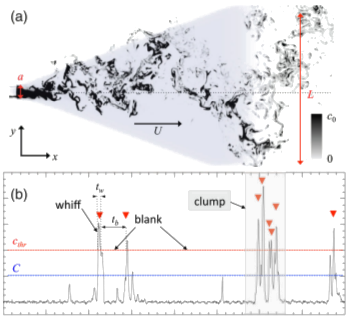Moth Navigation
November 12, 2014
Japanese-
themed and
produced film hit
American cinema with the 1956 release of
Godzilla, King of the Monsters!, an edited version of the 1954 Japanese film,
Godzilla (Gojira),
directed by
Ishirô Honda.[1] The
Godzilla monster proved so popular that other Japanese monster films emerged.
One other was the 1961 Ishirô Honda film,
Mothra, the star of which was the giant
moth monster,
Mothra.[2] Mothra was second in popularity only to Godzilla, and a
panoply of Mothra films were released over subsequent
decades. To me, one of the most interesting aspects of the original Mothra film was the pair of
foot tall
fairies who were guardians of the giant
egg from which the Mothra
caterpillar eventually hatches. You can see a short clip of the fairies,
here, and hear the Mothra
song, as sung by the fairies,
here.

Ishirô Honda, in 1954, leftmost in the left image, and Godzilla's star on the Hollywood Walk of Fame. (left image and right image, via Wikimedia Commons.)
Household chemicals intrigued me as a
child, and it seems to me that there were many more available sixty years ago than today, which is probably good from a
safety standpoint. One common household chemical item in the past, in the days before the rise of polyester, was
mothballs, which were designed to kill moths and their
larvae. The usual
chemical component of these was
1,4-dichlorobenzene (para-dichlorobenzene), a chemical that's
toxic to moths and their larvae (and, also,
harmful to humans). The chemical
sublimes; that is, it
transforms directly from a
solid to a
gas.

1,4-dichlorobenzene (para-dichlorobenzene).
(Illustration by author, rendered using Inkscape.)
The expression, "
like moths to flame," states the idea that
moths are
attracted to light, a likely consequence of an
instinctive navigation algorithm that allows them to
fly in a
straight line by keeping the
Sun, or the
Moon, off to one side; so, in effect, they aren't really attracted to the light, but prefer to travel in an
orthogonal direction. However, one thing that attracts a
male moth is a
female moth, and males find females through the
scent of their
pheromones.
Moths are small creatures, so females can't exude that much scent, but a male moth will fly in the right direction over hundreds of
meters even when
turbulence in the
air blows these pheromones every which way. Says
Massimo Vergassola, a
professor of
physics at the
University of California, San Diego, "The male moths are flying toward females integrating all of this
information along the way and somehow getting to them...
French naturalists reported this behavior over a
century ago and it has continued to be a puzzle to
entomologists,
neuroscientists and
physicists."[4]
Vergassola, along with
Antonio Celani of the
International Centre for Theoretical Physics, near
Trieste,
Italy, and
Emmanuel Villermaux of
Marseille University in
France, have authored a
paper, “Odor Landscapes in Turbulent Environments," on their investigation of this
phenomenon for the
journal,
Physical Review X.[3-5] Vergassola, Celani and Villermaux have
collaborated on similar studies in the past.[6-7]
The object of their study was the
Bombyx mori, commonly known as the silkworm moth, which is interesting for the fact that it does not occur
naturally in the wild, but exists as a consequence of
human cultivation for its
silk.
Experiment has shown that the male Bombyx mori responds to a
concentration of just 200
molecules of the pheromone,
bombykol, per
cubic centimeter.[3] This is good, since the female will produce just a few
picograms of the substance, corresponding to just ten
femtomoles, per
second.[3] Although the pheromone is widely dispersed under normal air conditions, the males are still guided through hundreds of meters with clues from scent puffs spaced tens of seconds apart.[4]

The caterpillar, male, and female forms of the silkworm moth, Bombyx mori. These illustrations are from an 1891 book, Schul-Naturgeschichte. (Modified Wikimedia Commons image.)
Turbulence is hard to analyze, but the physics team was able to use
Lagrangian and
statistical techniques develop a model of the male moth navigation.[4] The model gives limits on the
intensity and the duration of pheromone detections and their temporal spacing, and it was tested by
numerical simulation,
laboratory experiments, and field data on
atmospherics.[3] Says Vergassola,
“This a general problem—how animals, including ourselves, search for things... A similar problem exists for flies that can detect garbage cans far away, or for dogs that are guided by scents, although the difference is that their smells are generally on the ground, so their signals are much more stable. Insects face the most difficult problem as they rely on olfaction and detecting the volatile signals dispersed in the wind. When the atmosphere is turbulent, the signal becomes sporadic and simply disappears for long periods of time.”[4]
An important feature of the pheromone detection is a "
cone of detection" that extends downwind as far as 1,000 meters. Most pheromone detection occurs in
millisecond duration whiffs interspersed with periods of a few milliseconds, to tens of seconds, in which the pheromone cannot be detected.[4] This
research might enable unique olfactory sensing of such things as toxic chemicals, gas leaks, and
explosives.
robots could navigate much as the moths do to locate the sources of these scents.[4] This research was
funded by the
Agence Nationale de la Recherche.[3]

Top, a two-dimensional slice of a pheromone plume illustrating the cone of detection. Bottom, a time-series view of pheromone detection at a point in space.
(From fig. 1 of ref. 3, published under a Creative Commons Attribution 3.0 License.)[3]
![]()
References:
- Godzilla, King of the Monsters! (1956) on the Internet Movie Database. Godzilla ("Gojira," 1954) on the Internet Movie Database.
- Mothra (1961) on the Internet Movie Database.
- Antonio Celani, Emmanuel Villermaux, and Massimo Vergassola, "Odor Landscapes in Turbulent Environments," Phys. Rev. X, vol. 4, Document No. 041015, October 28, 2014. This is an open access paper with a PDF file here.
- Kim McDonald, "Physicists Solve Longstanding Puzzle of How Moths Find Distant Mates," University of California, San Diego Press Release, October 20, 2014.
- Katherine Kornei, "Synopsis: Beating Turbulence to Find a Mate, Physical Review X, October 28, 2014.
- Antonio Celani, Takeshi Matsumoto, Andrea Mazzino, and Massimo Vergassola, "Scaling and Universality in Turbulent Convection," Phys. Rev. Lett., vol. 88, Document No. 054503, January 18, 2002, DOI: http://dx.doi.org/10.1103/PhysRevLett.88.054503
- Antonio Celani and Massimo Vergassola, "Bacterial strategies for chemotaxis response," Proc. Natl. Acad. Sci., vol. 107, no. 4 (January 26, 2010), pp. 1391-1396.
Permanent Link to this article
Linked Keywords: Japan; Japanese; theme; film production; film; American; cinema; Godzilla, King of the Monsters!; Godzilla film; film director; Ishirô Honda; Godzilla; monster; Mothra film; moth; Mothra; panoply; decade; foot; fairy; fairies; egg; caterpillar; YouTube; song; Hollywood Walk of Fame; Wikimedia Commons; household chemical; child; safety; mothball; larva; larvae; chemical compound; chemical component; 1,4-dichlorobenzene; toxicity; toxic; harmful to humans; sublimation; phase transition; sublime; transform; solid; gas; Inkscape; like moths to flame; instinct; instinctive; navigation; algorithm; flight; fly; straight line; Sun; Moon; orthogonal direction; male; female; odor; scent; pheromone; meter; turbulence; air; Massimo Vergassola; professor; physics; University of California, San Diego; information; France; French; natural history; naturalist; century; entomology; entomologist; neuroscientist; physicist; Antonio Celani; International Centre for Theoretical Physics; Trieste; Italy; Emmanuel Villermaux; Marseille University; scientific literature; paper; phenomenon; scientific journal; journal; Physical Review X; collaboration; collaborate; Bombyx mori; nature; naturally; human; agriculture; cultivation; silk; experiment; concentration; molecule; bombykol; cubic centimeter; picogram; femtomole; second; Lagrangian mechanics; statistics; statistical; intensity; computer simulation; numerical simulation; laboratory; atmospherics; animal; housefly; garbage; waste container; can; dog; insect; olfaction; volatile organic compound; cone; millisecond; research; explosive material; explosives; robot; funding of science; Agence Nationale de la Recherche; two-dimensional; point; space; Creative Commons Attribution 3.0 License.